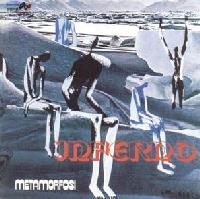 Whenever
I’m asked, I always say that Metamorfosi are just about my favorite
Itaprog band. Yet I prefer their first album to Inferno; and Inferno,
which I think came out around Christmas 1972, is the one that gets all
the attention. These guys have earned the reputation of being Christian
rockers, and they sure did some real Christian things on Inferno,
like putting the politicians in the innermost circle of hell. Of course,
my mild reservation regarding this record might stem from the fact that
when I read Dante’s Inferno – you know, the book –
I got so bored that my lower jaw began to detach from the skull. I mean,
to all intents and purposes I read that book in its entirety, but I never
did find out what the center of hell looks like. Someone told me it was
really cold, maybe like you see on the cover here. Not that I mind this
record – quite the contrary, the music is continuous, episodic,
well-conceived, and deftly executed. If I were to choose a favorite concept
album, this might be it, for it convincingly conjures up a Dantesque netherworld,
not just sonically but consciously through the vehicle of progressive
rock idiom, which it does much to characterize. While I might possibly
like the other better, therefore, this is the Metamorfosi deserving of
the classic epithet.
Whenever
I’m asked, I always say that Metamorfosi are just about my favorite
Itaprog band. Yet I prefer their first album to Inferno; and Inferno,
which I think came out around Christmas 1972, is the one that gets all
the attention. These guys have earned the reputation of being Christian
rockers, and they sure did some real Christian things on Inferno,
like putting the politicians in the innermost circle of hell. Of course,
my mild reservation regarding this record might stem from the fact that
when I read Dante’s Inferno – you know, the book –
I got so bored that my lower jaw began to detach from the skull. I mean,
to all intents and purposes I read that book in its entirety, but I never
did find out what the center of hell looks like. Someone told me it was
really cold, maybe like you see on the cover here. Not that I mind this
record – quite the contrary, the music is continuous, episodic,
well-conceived, and deftly executed. If I were to choose a favorite concept
album, this might be it, for it convincingly conjures up a Dantesque netherworld,
not just sonically but consciously through the vehicle of progressive
rock idiom, which it does much to characterize. While I might possibly
like the other better, therefore, this is the Metamorfosi deserving of
the classic epithet.
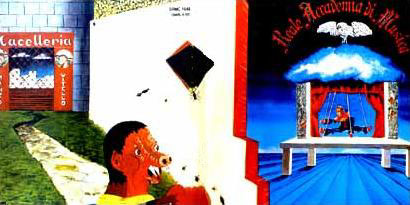 Just
don’t ask me about the cover, ok? The name of the group, and the
album that they put out in 1972, is Reale Accademia di Musica, which means
“Royal Academy of Music.” Cool name, but not exactly in step
with the times. So, the next time they recorded they gave the credit to
Adriano Monteduro, a classical guitarist, who helped write the songs and
sort of played along to the Academy’s instrumentation. By 1975, they
were not taking any credit at all, rather they were playing supporting
group to Nada, and not helping her to any more top ten hits either. Now,
the vocalist of the Academy has a Polish first name and a Spanish last
name, and he sounds pretty cool, but it’s like his voice is one of
the instruments, since all the instruments are very clear, in perfect
idiom (maybe a little too perfect, if what you’re looking for is
something where you can say prog definitely yes and pop definitely no),
well plausible to the listener, and carefully balanced.
Just
don’t ask me about the cover, ok? The name of the group, and the
album that they put out in 1972, is Reale Accademia di Musica, which means
“Royal Academy of Music.” Cool name, but not exactly in step
with the times. So, the next time they recorded they gave the credit to
Adriano Monteduro, a classical guitarist, who helped write the songs and
sort of played along to the Academy’s instrumentation. By 1975, they
were not taking any credit at all, rather they were playing supporting
group to Nada, and not helping her to any more top ten hits either. Now,
the vocalist of the Academy has a Polish first name and a Spanish last
name, and he sounds pretty cool, but it’s like his voice is one of
the instruments, since all the instruments are very clear, in perfect
idiom (maybe a little too perfect, if what you’re looking for is
something where you can say prog definitely yes and pop definitely no),
well plausible to the listener, and carefully balanced.
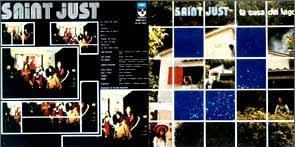 So
you’re thinking, hey, these Ita progrockers seem kind of misogynic,
don’t they, running around pretending they’re all Beethovens
or Tchaikovskys or something, and having these exclusive clubs, like,
and leave the wife at home. Well, here’s a formation fronted by a
pretty lady, and it gets wild, believe you me. Actually, this is the second
Saint Just. It’s called La Casa Del Lago, and it came out
in 1974. I’m showing you this one because I know you’ll like
it, but you’ll almost certainly like the first one as well. The songs
on these records have an undercurrent arriving from folk. To be sure,
it’s influenced by the contemporaneous British progressive folk music,
but it just doesn’t sound like that at all. There’s like gypsy
in it, something coming from the east, yet right there as part of the
everyday scene. I’m told that la casa del lago was
a house on the shore of Lake Bracciano, near Rome, which served
as the band’s comune.
So
you’re thinking, hey, these Ita progrockers seem kind of misogynic,
don’t they, running around pretending they’re all Beethovens
or Tchaikovskys or something, and having these exclusive clubs, like,
and leave the wife at home. Well, here’s a formation fronted by a
pretty lady, and it gets wild, believe you me. Actually, this is the second
Saint Just. It’s called La Casa Del Lago, and it came out
in 1974. I’m showing you this one because I know you’ll like
it, but you’ll almost certainly like the first one as well. The songs
on these records have an undercurrent arriving from folk. To be sure,
it’s influenced by the contemporaneous British progressive folk music,
but it just doesn’t sound like that at all. There’s like gypsy
in it, something coming from the east, yet right there as part of the
everyday scene. I’m told that la casa del lago was
a house on the shore of Lake Bracciano, near Rome, which served
as the band’s comune.
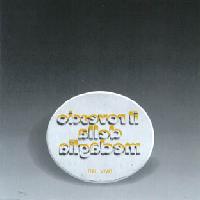 Il Rovescio
Della Medaglia – “the other side of the coin” – put
out three fine albums of which the first, La Bibbia (“The
Bible”), is definitely worth noting. It came out in 1971, a year
that saw several contributions to the birth of Itaprog, if not actual
examples of it. La Bibbia has most of the characteristic progressive
traits and can perhaps be regarded as the ‘first truly’ progressive
record from Italy. It is a ‘concept’ album with musical and
thematic continuity based on the Book of Genesis; it is music for music’s
sake, not fashion; and for variation it relies on contrasting passages,
not ‘songs’. An ‘unprogressive’ trait is its instrumentation:
a so-called ‘power trio’ of guitar, bass and drums, plus vocalist.
Yet Itaprog never made any formal demands regarding instrumentation, and
usually we find here the seemingly vulgar sound patterns of the power
trio woven into the artistic concept, for example on the track “Sodom
E Gommora”, leaving us with an overall impression that to carry off
a rock music representation of Genesis, the power trio is the only appropriate
vehicle. Some will find their third album, Contaminazione (1973),
more congenial, but it doesn’t quite rock like this. Incidentally,
if you have the LP of La Bibbia, be sure to make a cassette tape
in case you destroy the vinyl.
Il Rovescio
Della Medaglia – “the other side of the coin” – put
out three fine albums of which the first, La Bibbia (“The
Bible”), is definitely worth noting. It came out in 1971, a year
that saw several contributions to the birth of Itaprog, if not actual
examples of it. La Bibbia has most of the characteristic progressive
traits and can perhaps be regarded as the ‘first truly’ progressive
record from Italy. It is a ‘concept’ album with musical and
thematic continuity based on the Book of Genesis; it is music for music’s
sake, not fashion; and for variation it relies on contrasting passages,
not ‘songs’. An ‘unprogressive’ trait is its instrumentation:
a so-called ‘power trio’ of guitar, bass and drums, plus vocalist.
Yet Itaprog never made any formal demands regarding instrumentation, and
usually we find here the seemingly vulgar sound patterns of the power
trio woven into the artistic concept, for example on the track “Sodom
E Gommora”, leaving us with an overall impression that to carry off
a rock music representation of Genesis, the power trio is the only appropriate
vehicle. Some will find their third album, Contaminazione (1973),
more congenial, but it doesn’t quite rock like this. Incidentally,
if you have the LP of La Bibbia, be sure to make a cassette tape
in case you destroy the vinyl.
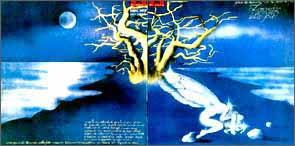 I
am sorry but we can’t spend any more time on this, so I’ve decided
to do the right thing and give you a real tip, if you’re interested
in Itaprog. I’m drawing your attention to Locanda delle Fate and
their Forse le lucciole non si amano pił from 1977. Because some
of the reviews you see might suggest that it’s a personal thing with
this record, that it’s just a matter of taste. When in fact it is
a classic. The problem is, well, there are a couple of problems, one being
that there was an earlier and well-liked band called Quella Vecchia Locanda.
But more importantly, Locanda delle Fate came out after almost all the
other prog bands had folded. So you might want to say that they weren’t
a part of the Itaprog wave. But these guys certainly didn’t see themselves
as an anachronism, and they added something significant to the genre.
This was basically it for Itaprog, however, for punk rock had already paved
the road for new wave.
I
am sorry but we can’t spend any more time on this, so I’ve decided
to do the right thing and give you a real tip, if you’re interested
in Itaprog. I’m drawing your attention to Locanda delle Fate and
their Forse le lucciole non si amano pił from 1977. Because some
of the reviews you see might suggest that it’s a personal thing with
this record, that it’s just a matter of taste. When in fact it is
a classic. The problem is, well, there are a couple of problems, one being
that there was an earlier and well-liked band called Quella Vecchia Locanda.
But more importantly, Locanda delle Fate came out after almost all the
other prog bands had folded. So you might want to say that they weren’t
a part of the Itaprog wave. But these guys certainly didn’t see themselves
as an anachronism, and they added something significant to the genre.
This was basically it for Itaprog, however, for punk rock had already paved
the road for new wave.